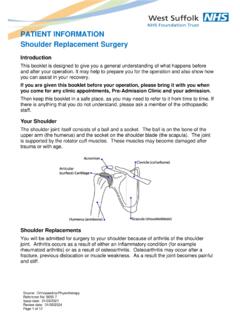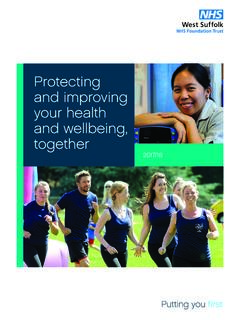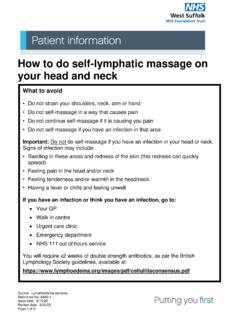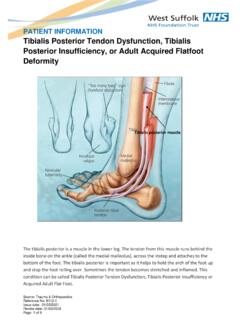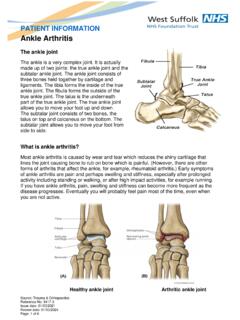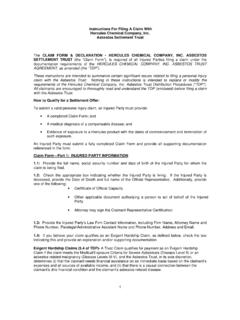Transcription of Heterozygous Factor V Leiden Mutation
1 Source: Haematology Department Reference No: 5843-2 Issue date: 5/7/18 Review date: 5/7/20 Page 1 of 5 Information for patients with Heterozygous Factor V Leiden Mutation What is Factor V Leiden ? Factor V Leiden is an inherited disorder that makes blood more likely to clot. If you have this disorder you are at risk of developing blood clots, especially in your leg veins. Most people with this disorder have no problems. Why does blood clot? Blood has a very important role; it carries nutrients and waste products around the body and carries oxygen from the lungs to all the other tissues. In order to do this, blood must remain a liquid, but at the same time, must be able to clot following injury.
2 Our bodies have developed a complex system of clotting factors in the blood to prevent serious blood loss after minor injuries. How does blood clot? When there is blood loss (eg from a cut finger) the clotting process is set in motion in order to prevent prolonged bleeding. The damaged blood vessels trigger a process that leads to a chain reaction in which one clotting Factor activates another, which in turn activates another and so on, until finally a clot is formed. Where does Factor V fit in? When blood clots, Factor V is converted to an active form called Factor Va, which helps to speed up clot formation. When bleeding stops however, clotting needs to be turned off.
3 Factor V Leiden is an abnormal form of Factor V, it works perfectly in the clotting pathway and speeds up clotting as expected, but it cannot be turned off easily. Therefore people with Factor V Leiden have an increased risk of developing blood clots. What is the cause of Factor V Leiden ? Genes are the DNA sequences that are the body s means of storing the information needed to produce chemical substances within the body (such as clotting Factor V). You have 2 copies of most genes, one copy being inherited from each of your parents. Heterozygous means that the 2 copies of a gene are different. In your case, one of your Factor V gene codes is for normal clotting Factor V and the other Factor V gene code is for Factor V Leiden .
4 There is more risk of a blood clot if both gene codes are for Factor V Leiden (ie in the homozygous state). Factor V Leiden is due to an error in the DNA sequence of the Factor V gene. Approximately 1 in 25 people are born with one Factor V Leiden gene and around 1 in 650 are born with two. If I have Factor V Leiden .. What problems will I have? You have an increased risk of developing blood clots in the circulation. These usually occur in veins, especially in the legs. A blood clot in the deep veins of the leg is called a deep vein thrombosis or DVT for short. When a DVT develops, blood cannot drain out of the leg properly and the leg becomes swollen and painful and sometimes also hot and inflamed.
5 Very occasionally blood clots can form in the veins around the shoulder causing a swollen, painful arm. The main concern about a DVT is that part of the clot can break off and pass through the heart to the main artery of the lungs. This is called a pulmonary embolus or PE for short. A PE blocks the blood supply to the lungs and can cause chest pain and breathlessness. When am I likely to have problems? It is important to realise that not everybody with Factor V Leiden will develop a blood clot. In fact, many cases are found during family studies in otherwise healthy people. It is very unusual for clots to develop in childhood, but by the age of twenty a few affected people will have suffered at least one blood clot.
6 The incidence then increases with age. Clots occur more frequently after operations, during pregnancy and following immobility, such as long-haul flights or when dehydrated. Women on the combined contraceptive pill also have a higher risk of thrombosis than normal. In some cases the blood clot occurs without any obvious cause. How will I be treated? If you have a DVT or PE you will receive standard treatment with anticoagulants medication for a standard length of time, ie 3 6 months. Present advice is that you do not require anticoagulant treatment if you have never had a blood clot. What is the risk of developing a blood clot (thrombosis)? The risk of venous thrombosis in individuals with Factor V Leiden inherited from only one parent ( Heterozygous ) is approximately 5 times higher than normal.
7 An additional environmental or genetic risk Factor for venous thrombosis is usually present at the time of a thrombosis. What if I have had a blood clot? You will be treated with anticoagulant medication for a standard length of time (ie 3-6 months). You should follow the advice below to minimize the risk of further clots. Anticoagulant medication has, by its nature, a risk of bleeding which your doctor will need to assess when starting treatment. Whether you should be treated with anticoagulant medication for longer than the standard length of time, should be discussed with your doctor. The decision to treat for longer will depend on a number of issues (such as provoking factors and where the clot was), which have to be carefully balanced to minimize the risk of further blood clots and the risk of bleeding on anticoagulants.
8 How can I reduce the risk of blood clots? Stop smoking; smoking increases the bloods ability to clot. Achieve your ideal weight; obesity increases the risk of clotting. Inform your doctor about your condition if you require surgery. You will require heparin or a similar medication around the time of surgical procedures. Compression stockings may also be used. Avoid long periods of immobility. For a long-haul flight you may be recommended to take a preventative dose of heparin before the flight (and possibly after the flight). You should also walk around the plane when you can, avoid alcohol and drink plenty of water. You may be advised to wear compression stockings or flight socks for journeys longer than three hours.
9 A haematologist can provide the latest advice with regard to travel. Avoid dehydration. Information for women What if I want to take the contraceptive pill? In general, women taking the combined (oestrogen and progestogen) contraceptive pill are 4 times more likely to develop blood clots than women not on the combined contraceptive pill. The presence of the Factor V Leiden Mutation increases this risk further. Although the figures sound alarming it should be remembered that blood clots occur very rarely in young women on the pill. It is recommended that women with Factor V Leiden use an alternative form of contraceptive if possible, especially if they have already had a blood clot or they have first degree blood relatives with a history of blood clots.
10 You should discuss alternatives with your doctor. What if I become pregnant? If you have already had a blood clot: You will need anticoagulant medication during pregnancy in the form of heparin injections. The highest risk period is usually during the late stages of pregnancy (third trimester) and the six weeks after delivery. You will also need to wear graduated compression stockings. Your obstetrician or a haematologist can advise when to start the heparin injections and to wear compression stockings and when to stop. You should inform your GP and midwife of your condition as soon as you know you are pregnant, but ideally If you have never had a blood clot: Anticoagulant medication may not be necessary during pregnancy.


